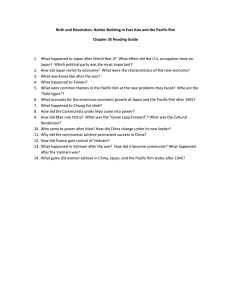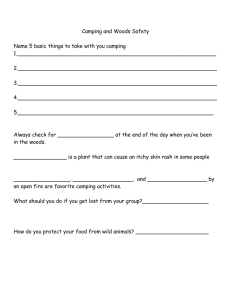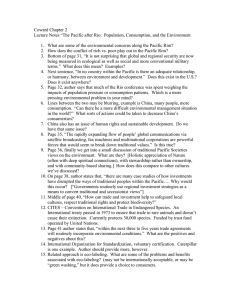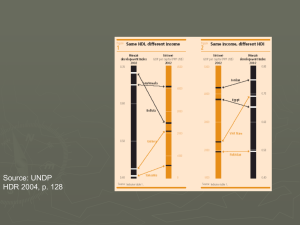2016 Paddler`s Preparation Guide
advertisement
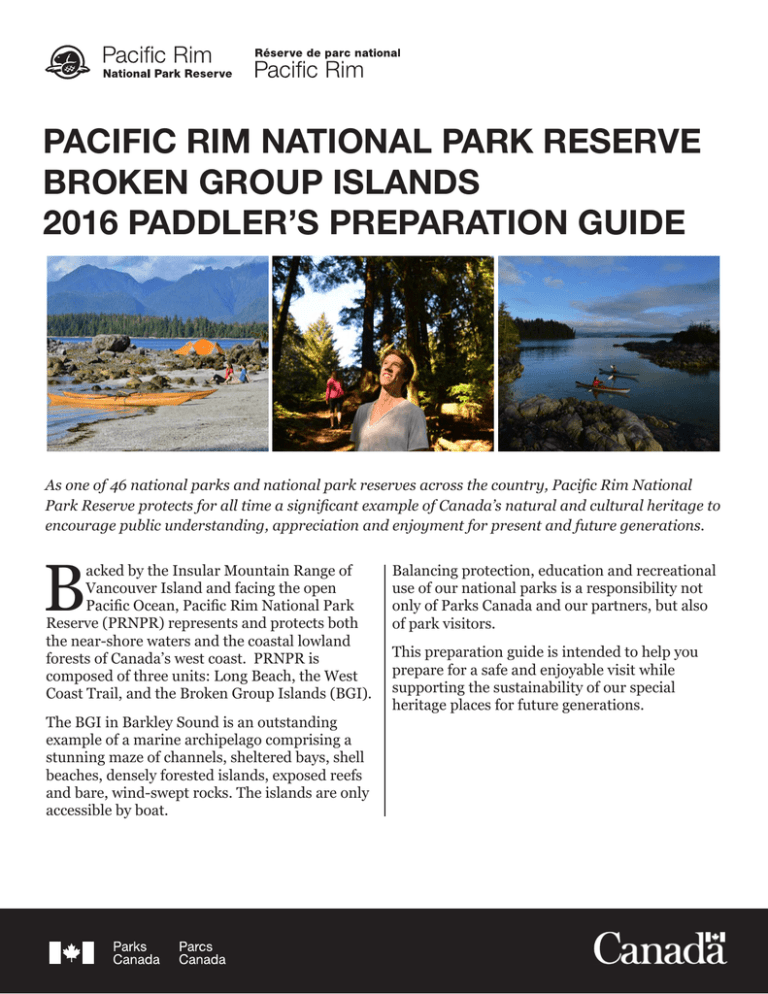
PACIFIC RIM NATIONAL PARK RESERVE BROKEN GROUP ISLANDS 2016 PADDLER’S PREPARATION GUIDE As one of 46 national parks and national park reserves across the country, Pacific Rim National Park Reserve protects for all time a significant example of Canada’s natural and cultural heritage to encourage public understanding, appreciation and enjoyment for present and future generations. B acked by the Insular Mountain Range of Vancouver Island and facing the open Pacific Ocean, Pacific Rim National Park Reserve (PRNPR) represents and protects both the near-shore waters and the coastal lowland forests of Canada’s west coast. PRNPR is composed of three units: Long Beach, the West Coast Trail, and the Broken Group Islands (BGI). The BGI in Barkley Sound is an outstanding example of a marine archipelago comprising a stunning maze of channels, sheltered bays, shell beaches, densely forested islands, exposed reefs and bare, wind-swept rocks. The islands are only accessible by boat. Balancing protection, education and recreational use of our national parks is a responsibility not only of Parks Canada and our partners, but also of park visitors. This preparation guide is intended to help you prepare for a safe and enjoyable visit while supporting the sustainability of our special heritage places for future generations. 2 FIRST NATIONS The traditional territories of the Nuu-chah-nulth First Nations encompass the Broken Group Islands. The islands contain many sites of spiritual and cultural significance for the Tseshaht and Hupacasath First Nations. Disturbing, destroying or removing natural and cultural artifacts is strictly prohibited without prior written permission or licences. This regulation is strickly enforced: carry all licences with you. There are First Nation reserve lands on Effingham, Nettle, and Keith Islands. Day visitors are welcome at Keith Island. Written permission from the appropriate First Nation is required prior to landing on Effingham and Nettle reserve lands. Boaters are asked to refrain from tying up to the reserve wharf on the south-east side of Nettle Island. CLIMATIC INFLUENCE The BGI enjoys a moderate maritime climate of cool foggy summers and mild wet winters with an average annual precipitation of 330 centimeters (130 inches). This climate encourages an abundance of life both in the water and on the land. No other temperate region on earth has a more bountiful, diverse, intertidal zone than North America’s nutrient-rich Pacific coast. The mild climate also encourages the lush growth of temperate rainforest dominated by coniferous tree species such as Sitka spruce, western hemlock and western redcedar. PREPARATION INFORMATION Is your party ready for a trip to the BGI? Long known as the “Graveyard of the Pacific”, this area abounds with potential hazards. Though marine navigation techniques and tools have improved Pacific Rim National Park Reserve of Canada since the title was bestowed, the area’s hazards remain. Trip preparation is a crucial element of any visit to the BGI. Your ability to recognize and evaluate hazards is key to determining the risk you and your group are taking. To have a safe experience, your party’s knowledge, skills and equipment must meet or exceed the challenges of this environment. You and your group should be able to: • plot a course by chart and compass; • pilot your vessel(s) safely in fog; • read weather patterns and signs, obtain and interpret up-to-date marine weather forecast; • assess water hazards that vary with tide, sea state and weather; • interpret tide tables; • competently handle your boat if caught in adverse conditions (some crossings may take 3 or more hours); • perform a group rescue and self-rescue; • camp in prolonged windy and rainy conditions; • call for help; and • administer first aid. CUSTODIAL GROUPS Groups that are affiliated with an institution, and have at least one person below the age of majority who is not accompanied by his/her parent or guardian, have special considerations when kayaking and/or canoeing in Pacific Rim’s marine waters. These groups are required to obtain in advance, and carry with them, an activity permit issued by Pacific Rim National Park Reserve. Please contact the park reserve staff prior to arrival for information and appropriate permits. PARKS CANADA PRESENCE The BGI is patrolled by the Tseshaht Beachkeepers throughout the summer months to maintain camping areas, provide information and interpretation services, check permits, and assist Parks Canada staff in a variety of ways. Broken Group Islands Paddler’s Preparation Guide 2016 3 ACCESS CAMPING Road Access: Camping in the High Season Paddlers can park and launch kayaks from the Toquaht Nation’s Secret Beach Campground and Kayak Launch. For more information regarding fees and directions please refer to the Secret Beach Campground and Kayak Launch contact information in the Other Services section on page 8. Peak visitation occurs in the BGI from mid-July through August. Campers arriving in this period can expect to share camping areas with many other visitors. To avoid peak season crowds, try camping between May 1st and early July, or in September. Drop off by marine transport: Transport companies with valid PRNPR business licenses are permitted to drop clients off throughout the islands (excluding designated camping areas). With permission from the Tseshaht First Nation Beachkeepers, Keith Island has a dock, outhouse and sheltered area to facilitate drop off and pick up. See Other Services on page 8 for Beachkeeper and marine transport companies’ contact information. Lady Rose Marine Services Limited carries paddlers and their boats on a scheduled basis to the protected waters just north of the BGI. See Other Services on page 8 for their contact details. Paddling from Bamfield or Ucluelet is not recommended due to the exposed passages of Imperial Eagle and Loudon Channels. Kayak rentals are available from operators based in the nearby communities. Commercial companies must have a PRNPR business licence if operating in the BGI. Carefully select a company that meets the needs of your group. Visit out website or contact Parks Canada for a list of commercial operators that hold Parks Canada business licences. Note: Due to weather and/or operational concerns, the Broken Group Islands, or portions of it, may not be accessible to the public. Pacific Rim National Park Reserve of Canada Camping Regulations • Camping in the BGI must be within the designated camping areas on Hand, Turret, Gibraltar, Willis, Dodd, Clarke, and Gilbert Islands. Check your chart for their exact locations • Maximum stay in the BGI is 14 days. • Maximum stay at any one camping area is 4 nights. • Maximum group size is 12. Groups larger than 12 people must split into smaller groups and occupy designated campsites on different islands. This applies to private, commercial, and non-profit groups. • Dogs are prohibited. Pets disturb wildlife, interfere with other visitors’ enjoyment of the area and can introduce disease to island wildlife. • Regulations are enforced. Camping Permits and Fees • Anyone camping in the BGI must have a camping permit. • Camping fees are $9.80 per person per night from May through September. • Camping permits are available in person from the following locations (credit, debit and cash accepted): • Toquaht Nation’s Secret Beach Campground and Kayak Launch • Pacific Rim Visitor Centre located at the Tofino-Ucluelet junction • Alberni Valley Chamber of Commerce • Ucluelet Chamber of Commerce • Parks Canada Administration Office across from Green Point Campground Broken Group Islands Paddler’s Preparation Guide 2016 4 • Camping permits are also available from Parks Canada by phone at 250-726-3500, Monday through Friday – 8AM to 4PM. If calling to order by phone please ensure that you have your travel dates, number of people in your party, number of nights you are planning, and your credit card information. • Contact Parks Canada for up-to-date fee schedules prior to your departure. Fees may change at any time. Consider the Needs of other Campers • This is a wilderness setting: refrain from using generators, stereos or air compressors. • Leave space between you and your neighbour. • Cook away from neighbouring tents. • Neither private nor guided groups may reserve campsites. Your Impacts on the Environment Parks Canada strives to manage activities within the national park reserve to protect the natural and cultural heritage of the area. Your appropriate, respectful behaviour (low impact camping) will not only lead to a safe and rewarding experience but will also contribute to a healthy, functioning ecosystem. Parks Canada, First Nations and visitors’ collective actions will ultimately ensure that future generations can appreciate and enjoy this special place. When you leave a camping area, ensure the area is in at least as pristine a condition as when you found it. • Store food and garbage securely, either inside kayak hatches or in rodent and crow-proof containers. You are living with wildlife in the islands. • Pack out all garbage. There is no garbage pickup in the BGI. • Use solar composting outhouses for bodily waste only. They are not compost piles for food scraps. • Do not dig trenches around tents and when leaving, replace rocks that have been used to secure tent pegs. • Use a camp stove rather than a fire for cooking. • Keep fires to a minimum, always below high tideline, and never in the forest. Do not burn wood any thicker than your wrist and ensure the fire has burned out completely before you leave the area. Never abandon a fire: smouldering fires have ignited, burning the ancient rainforest. • Assess the area for dangerous trees before setting up camp. Campground Hardening and Rehabilitation Parks Canada performs restoration work to protect exposed shell middens, bare roots and mineral soils on the campground islands. Please respect any fencing or signage you may encounter. Tips: • Use biodegradable soap. • Use ropes (not nails) to hang tarps etc. • Remove all ropes. Disassemble primitive furniture and structures before departing. • Leave all vegetation as you find it. A rare lichen, the seaside centipede lichen, has been found in the BGI. Breaking lower branches from trees could have a devastating impact on the species. Pacific Rim National Park Reserve of Canada Broken Group Islands Paddler’s Preparation Guide 2016 5 HAZARDS AND REGULATIONS To help you maximise the enjoyment and safety of your trip below are some hazards and responsibilities your entire party should be aware of before setting out: Weather: Strong winds can funnel through channels. Winds tend to rise in the late morning and drop in the evening. Travel through Loudon and Imperial Eagle Channel by kayak, canoe and small craft is not recommended. During fair weather, winds blow predictably from the west and northwest. Winds are from the southeast just before and during adverse weather. However, there are always exceptions to wind and weather patterns. Wind-generated waves, especially those influenced by currents, can make for extremely rough or hazardous paddling and small craft handling. Boaters should plan on moderate to severe chop in Coaster Channel during the middle of the day, particularly when it is hot and sunny. Travel through Coaster Channel when winds are light (generally early morning). Heavy wind, rain, fog, and strong tidal currents here can be extremely dangerous. Knowledge of navigation, boat handling, wilderness survival, weather patterns and signs, is essential for travel and camping in the area. Sea State: Large ocean swell (long distance ocean-generated waves), steep chop (local windgenerated waves), tidal currents, cold water; all pose potential problems for boaters. Seascape: A maze of islands, islets, reefs, submerged rocks, and surge channels can be difficult to navigate at any time, but are particularly dangerous in ocean swell or limited visibility. generate heat and is a major killer of outdoor recreationists. Boaters beware; body heat is lost 25 times faster in water than in air. The maximum survival time in 10ºC water is 2-3 hours. The water temperature in Barkley Sound ranges from 7-15ºC. Know how to prevent, identify and treat hypothermia. Stinging plants and insects are present on the islands. Group Travel: The following represent best practices for group travel: • Travel in a group of three or more boats to facilitate rescue and emergency response. Self-rescue may be the difference between life and death. • Be prepared for a capsized or damaged boat; more importantly, avoid situations that may be hazardous. • Stay within normal talking distance of one another and follow shorelines where possible. • Know the abilities (mental and physical) of each member of your group and plan accordingly. • Travel at the speed of the slowest group member. • Regularly assess the condition of group members. • Alcohol and wilderness settings do not mix. • Personal hygiene while camping can be challenging; wash hands frequently. Freshwater: Freshwater sources are unreliable in Barkley Sound; bring all the potable water your group requires. We recommend 4-6 litres per person, per day. Marine Traffic: Kayaks, sailboats and motorboats all use the BGI. Motorized vessels often cannot see paddlers nor are they visible on radar. Know your responsibilities. All marine traffic is subject to marine collision regulation. Contact The Boating Safety Info Line for details. See Other Services for their contact information. Hypothermia: Hypothermia is the lowering of the core body temperature below a safe level causing the body to lose the ability to Pacific Rim National Park Reserve of Canada Broken Group Islands Paddler’s Preparation Guide 2016 6 LIVING WITH WILDLIFE MARINE HARVESTING IN PRNPR Viewing wildlife while in the BGI is exciting. Please remember that you have responsibilities as well as opportunities when you encounter wildlife. Are you thinking of catching or harvesting finfish, shellfish or other marine creatures? Please note that the national park reserve is a voluntary no-harvest zone. The national park reserve was established to protect the diversity of life in this area for present and future generations. With your help, Parks Canada can protect both the marine and the terrestrial environment. Bare Campsite Program: leave no food items or other attractants, such as food packaging, toothpaste, soap, dish rags/ scrubbers and pots/pans unattended. Scavenging animals such as crows, deer, rodents, raccoons and even wolves are efficient and creative scavengers. Secure food and other attractants in tightly closed containers when not in immediate use. Black bears, wolves and cougars are in the BGI. To avoid a dangerous encounter with wildlife stay alert and watch for signs of recent activity. Keep these points in mind: • Keep children close to you. • If you encounter a predator, face the animal and retreat slowly, giving them an avenue of escape. • Do not run or play dead. • If the animal does not leave or approaches, try to scare it away by appearing big and aggressive: shout, wave a stick/paddle or throw rocks. • In the unlikely event of an attack fight back; target the eyes and nose. Sea lions, seals and whales are frequently sighted. There are established guidelines for viewing marine wildlife, these guidelines require boaters, including kayakers, to keep a minimum distance from all marine wildlife. For federal guidelines referring to marine mammal viewing, contact the Department of Fisheries and Oceans (DFO) (see contact section). Harvest limits are reduced within PRNPR. If you are harvesting you must carry the appropriate licenses (Tidal Waters Sports Fishing Licence) and follow the DFO regulations and closures. As of August 14th, 2002, DFO permanently closed a large section of the BGI to fin-fishing. This area is now a Rockfish Conservation Area (RCA). Consult DFO for details of this closure. Naturally occurring toxins such as Paralytic Shellfish Poisoning (PSP) - or “red tide” - have been found in the shellfish in Barkley Sound (e.g. clams, oysters and scallops). When humans consume contaminated shellfish, symptoms can vary from a mild tingling of the lips and tongue, to paralysis and death. Shellfish harvest openings and closures are based on rigorous monitoring procedures by DFO (see contact section). Boating near caves and cliffs impacts nesting seabirds and is hazardous. Stay well away from these features. Regulations prohibit entry into caves. Note: sea lions are known to carry a disease called leptospirosis that can be transferred to humans. Accordingly, never touch a marine mammal, dead or alive. Pacific Rim National Park Reserve of Canada Broken Group Islands Paddler’s Preparation Guide 2016 7 Recommended equipment: TRIP PLAN File a trip plan before you leave for the backcountry, with a reliable person and upon completion of your trip, inform your contact that you are out of the backcountry. A trip plan should be in writing and include: • The number of people in your group; • Trip length in days; • Arrival and departure times and dates; • Specific route plans; • Camping plans; • Tent: number, make/model/colour of tent; • If applicable, vehicle licence #, make/model/ colour and location; • If applicable, the make and colour of each vessel. EQUIPMENT Regulated equipment: See Canada Coast Guard Safe Boating Guide or contact Office of Boating Safety for equipment that must be carried on board your vessel. Pacific Rim National Park Reserve of Canada • Hyrdographic (nautical) charts #3670 and #3671 and a waterproof chart bag • Canadian Tide and Current Tables (refer to Tofino tables) • GPS with chart plotter and tide table • Watch • Licenced marine VHF Radio • Compass • Cellular phone (check with your carrier for coverage) • First aid kit • Survival kit (e.g. waterproof matches, knife, emergency food, flares and blanket) • Equipment repair kit • Personal Flotation Device (PFD) and whistle • Self-rescue aids, paddle floats, towlines • Paddling gloves, hat • Wetsuit • Potable water • Stove, fuel and cooking kit • Food • Knife • Rope, shock cords • Tent with waterproof fly and floor • Sleeping bag and insulation pad • Waterproof bags • Flashlight • Toiletries (hand sanitizer, sun- and lip-screens) • Sunglasses • Airtight container for garbage • Toilet paper • Camera • Spare paddle • Air horn (for scaring wildlife away) • Pepper spray • Clothing; choose materials that maintain warmth when wet, dry quickly, can be layered (wool or polypropylene) • Durable rain gear (test it beforehand) • Warm hat and gloves • Footwear • Towels Broken Group Islands Paddler’s Preparation Guide 2016 8 CONTACT PACIFIC RIM NATIONAL PARK RESERVE Pacific Rim National Park Reserve Administration Office 2040 Pacific Rim Highway P.O. Box 280, Ucluelet, BC V0R 3A0 250-726-3500 (year-round) Pacific Rim National Park Reserve Resource Conservation & Park Warden Office (24 hours) 1-877-852-3100 (toll-free) or 1-250-726-3604 Parks Canada Information Pacific Rim Visitor Centre 2791 Pacific Rim Highway 250-726-4212 Open daily May to September pacrim.info@pc.gc.ca www.pc.gc.ca/pacificrim Email: Website: OTHER SERVICES (subject to change) Beachkeepers, Tseshaht First Nation 1-250-266-0620 Secret Beach Campground and Kayak Launch - Toquaht Nation 250-726-8349 www.secretbeach.ca secretbeach@toquaht.ca 250-723-8313 or 1-800-663-7192 (April 1 - Sept 30) www.ladyrosemarine.com (Port Alberni to Bamfield/Ucluelet) 2791 Pacific Rim Highway 250-726-4600 pacificrimvisitorcentre@telus.net www.pacificrimvisitor.ca 2533 Redford Street Port Alberni, BC V9Y 7L6 250-724-6535 office@albernichamber.ca 250-728-3006 info@bamfieldchamber.com www.bamfieldchamber.com 1-888-223-3779 or 250-386-3431 (international) *BCF on cell www.bcferries.bc.ca (Vancouver, Victoria, Nanaimo) Lady Rose Marine Services (Passenger Ferry) Ucluelet Chamber of Commerce, Pacific Rim Visitor Centre Alberni Valley Chamber of Commerce Bamfield Chamber of Commerce Bamfield Centennial Park & Campground and Information Center BC Ferries Fisheries and Oceans Canada Pacific Region Port Alberni Office Nuu-chah-nulth First Nations Tribal Council Transport Canada Office of Boating Safety Pacific Rim National Park Reserve of Canada 250-720-4440 Fishing and Paralytic Shellfish Poisoning Information 24 hour line [sub area23 (8)] 604-666-2828 or 1-866-431-3474 www.dfo-mpo.gc.ca 1-877-677-1131 or 250-724-5757 www.nuuchahnulth.org 1-866-995-9737 www.tc.gc.ca/eng/marinesafety/debs-obs-menu-1362.htm Broken Group Islands Paddler’s Preparation Guide 2016
